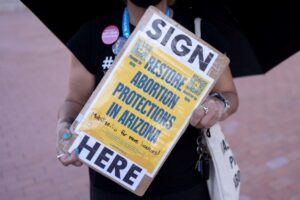During the three weeks of testimony in the trial of Minneapolis cop Derek Chauvin for murdering George Floyd, an estimated 64 people were killed by law enforcement across the U.S.—averaging three deaths per day.
They included 13-year-old Adam Toledo, who was gunned down by a Chicago police officer in the early morning hours of March 29. The cop’s body cam shows him shooting Toledo once in the chest immediately after the boy put his empty hands in the air, as he was ordered to do.
The dead also included 20-year-old Daunte Wright, shot and killed during a traffic stop in Brooklyn Center, just ten miles from Chauvin’s murder trial.Wright was pulled over for the minor “crimes” of a small air freshener dangling from his rear view mirror and expired license plates, a common occurrence during the pandemic backlog. When the police discovered an outstanding warrant for a missed court date on a misdemeanor charge, they moved in to arrest him. He panicked and forced his way back into his car.
Body cam video shows Kimberly Potter, a 26-year police veteran, shoot him dead after shouting “Taser! Taser! Taser!” Potter claimed she mistook her pistol for a taser—although the two are of starkly different colors and weights. Wright was unarmed and presented no threat to Potter’s life. The day after Wright’s shooting, the Brooklyn Center police department hoisted a “Thin Blue Line” flag to express their solidarity with Potter, who was also president of the local police union.
Like Chauvin, Potter is one of the few police charged with a crime after committing a homicide—in her case, the charge was manslaughter. But Chauvin and Potter share something else in common: Both were Field Training Officers, assigned to train rookie cops on the job, presumably because their superiors held them in high regard. Both murdered their victims while in the process of “teaching” their trainees.
Why Chauvin’s conviction was a surprise
On April 20, as the judge read out the guilty verdicts against Chauvin,crowds waiting outside the Minneapolis courthouse erupted in cheers and tearful embraces, expressing joy and disbelief at this outcome. The jury found Chauvin guilty of all charges—second-degree murder, third-degree murder, and second-degree manslaughter—which could bring a sentence of up to 40 years in prison.
Activists had expected the worst outcome, because police murder convictions are exceedingly rare despite roughly 1,000 civilian deaths at the hands of law enforcement every year.Young Black men are the most likely to be killed by police, followed by young Latinos, military veterans and people experiencing mental health crises. Native Americans are often overlooked in the statistics, because they make up a much smaller part of the U.S. population, but they are killed by police at a higher rate than any other racial group.
The 9-minute and 29-second video of the stone-faced Chauvin, with his full body weight holding Floyd’s back down while pressing his knee mercilessly against his neck—continuing for two minutes after Floyd no longer had a pulse—left no doubt about Chauvin’s guilt for anyone with an ounce of humanity.That video of George Floyd’s murder sparked a worldwide protest movement last summer—because police brutality is such a common feature of law enforcement under capitalism everywhere, along with the racism that is key to justifying it.
Since a 1989 Supreme Court decision, police have been able to legally claim that they feared for their lives when using deadly force, even if the benefit of hindsight later determines that no such danger existed. This claim has typically prevented a conviction, even when police shootings are captured on video and lead to mass protests—including Michael Brown’s murder in Ferguson, MO in 2014 and Philando Castile’s in Minneapolis in 2016.
Chauvin’s defense team predictably relied on portraying the “fear” that the expressionless Chauvin must have felt from the angry mob (a mere dozen of mostly Black and Brown bystanders who, from the sidewalk, begged the cops not to kill Floyd). Chauvin’s lawyers also claimed that Floyd’s drug use made him exhibit “excited delirium” and possess “superhuman strength,” which might cause him to rise up and overpower Chauvin, even after Floyd was rendered unconscious. On the other hand, the defense argued, the small amounts of Fentanyl and Methamphetamine, or Floyd’s history of heart disease, or even his previous bout of Covid-19 might have caused his death, rather than Chauvin’s murderous actions.
All of these racist tropes are recycled after virtually every police killing of Black and Brown people,as a means to blame the victims for their own deaths.
The “one bad apple” prosecution strategy
In Chauvin’s trial, prosecutors followed a strategy that painted Chauvin as one “bad apple” among a largely honest and ethical police force. In his closing arguments, the prosecuting attorney left no doubt when he stated, “This is not an anti-police prosecution. It’s a pro-police prosecution.”
The prosecution called one police witness after another—most significantly, Minneapolis Police Chief Medaria Arradondo, who stated unequivocally, “To continue to apply that level of force to a person proned out, handcuffed behind their back…that in no way, shape or form is anything that is by policy,” adding that Chauvin’s behavior was “not part of our training. And it is certainly not part of our ethics or our values.”
Yet Field Training Officer Derek Chauvin had received at least 22 complaints or internal investigations (far higher than most police) in his 19-year career with the Minneapolis Police Department, most for using excessive force. Only one, early in his career, resulted in a reprimand. After that, Chauvin received no more reprimands but rather two medals of commendation and two medals of valor for his job performance in the line of duty—not to mention his prestigious assignment as a Field Training Officer.
The Minneapolis Police Department banned chokeholds and forcible neck restraints last summer after Floyd’s murder. But until then, as Arredondo testified, “Neck restraints were defined in the policy as a “non-deadly force option.” At what point did Chauvin begin violating Minneapolis police policies—which were so inhumane to begin with?
The police code of silence and the system that encourages it
Before Chauvin’s conviction only seven cops had been convicted of murder since 2005; only 1.1 percent of officers even get indicted annually after a police-involved killing. Largely, this is because of what is known as the “blue wall of silence” among cops, who refuse to investigate or otherwise cooperate in probes of the alleged crimes of their fellow officers. Prosecutors usually decide not to press charges against police, who are their closest collaborators in enforcing the law, such as it exists. Cops who try to challenge this police code of silence are typically bullied into submission.
Andrew Rodriguez is one of the few new recruits who refused to comply with the pressure of older sheriff’s deputies. He filed a lawsuit against Los Angeles County, and a jury awarded him$8.1 million for “workplace harassment” in 2020. The Marshall Project described,
Andrew Rodriguez was just out of patrol school, eager to learn how to use his academy training in the real world, from real sheriff’s deputies in Los Angeles County.
But what his field trainers tried to teach him, he testified in September, was how to be a bad cop: to lie that he had found a meth pipe in a suspect’s pocket, to harass Black people for no reason, to threaten women into giving up information. When he wouldn’t go along, Rodriguez said, the trainers bullied him.
Field trainers “serve as gatekeepers for this fraternity where lying and illegal stops are encouraged and rewarded,” said Alan Romero, a civil rights lawyer who represented Rodriguez.
Lawmakers and courts are equally implicated in this entire process. Legislatures in most states have passed laws criminalizing everything from tinted windows, broken signal lights, or small objects dangling from a rear view mirror, that legally justify police traffic stops.The police then routinely use traffic stops over such minor offenses as a “pretext” to search the drivers’ records for arrest warrants, hunt through the car for drugs and weapons, or to check their immigration status. Researchers from Stanford University’s Open Policing Project who examined more than 100 million traffic stops nationwide found that Black drivers more likely to be stopped than those of any other race.
The U.S. Supreme Court ruled in 1996 that pretext stops are constitutional as long as police officers identify an actual violation of traffic law during the stop, however minor.
Working-class people of color on the receiving end of this treatment experience a vicious cycle: Minor law violations allow police to carry out traffic stops as a means to write tickets that raise revenue for their local governments, while also ensnaring a disproportionate number of Black and Brown, and working-class residents into the criminal system for missed court dates and unpaid tickets that they cannot afford—especially after losing their jobs for serving jail time.
The “war” mentality of police
The “war on drugs” that first gained steam in the 1980s was explicitly aimed at drug possession and low-level dealing, using militarized SWAT teams and other heavily armed police executing “no-knock” or “quick-knock” warrants. In March of 2020, Louisville police shot and killed 26-year-old Breonna Taylor as she slept at her home during a no-knock warrant in search of drugs at the wrong address. No police officer has been charged in her death, which sparked months of Black Lives Matter protests around the country and accelerated after the murder of George Floyd.
Such raids have been justified as necessary to prevent drug dealers from destroying evidence before the cops could enter the residence, and most raids are conducted overnight to maintain the element of surprise. In the 1990s, the U.S. Supreme Court allowed police broad leeway to enter a residence without knocking if they had “reasonable suspicion” that the suspect could destroy evidence,or their own lives could be put in danger. While these types of raids were conducted about 1,500 times in the early 1980s, by 2010 the figure had risen to 60,000-70,000 annually, most of them in search of marijuana.
In 2014, the American Civil Liberties Union (ACLU) analyzed data on SWAT team deployments and found that drugs were found in 36 percent of cases, while not found in 35 percent. In 29 percent, the information was not reported. But the War on Drugs also had a far-reaching impact on incarceration rates, especially among people of color convicted of non-violent crimes. The International Centre for Prison Studies reported in 2018:
- There were more than 1.5 million drug arrests in the U.S. in 2016. The vast majority – more than 80% – were for possession only.
- People of color experience discrimination at every stage of the judicial system and are more likely to be stopped, searched, arrested, convicted, harshly sentenced and saddled with a lifelong criminal record. This is particularly the case for drug law violations.
- Research shows that prosecutors are twice as likely to pursue a mandatory minimum sentence for black people as for white people charged with the same offense. Among people who received a mandatory minimum sentence in 2011, 38% were Latino and 31% were black.
Another reason for the high rate of police killings is that police are armed with a taser on one hip and a gun on the other, even in the most routine of traffic stops—the vast majority of which pose no threat to their safety. The mentality among police officers, however, is that every traffic stop poses a risk to their lives, contributing heavily to the cops’ perception that they are at war with the local population—especially if it is predominantly Black or Brown.
To be sure, the U.S. population is the most heavily armed population in the world, with between one-third and one-half of households owning at least one gun. With just four percent of the world’s population, Americans own roughly 40 percent of civilian-owned guns globally.
Nevertheless, policing is not even among the top twenty most dangerous occupations in the U.S. The most lethal occupation by far is logging, with a fatality rate that is 33 percent higher than the average job. Police rank 22nd highest—a lower rate than delivery drivers (7th) and crossing guards (12th). Police face a risk on the job similar to heavy vehicle mechanics (20th) and grounds maintenance workers (21st).
In 2020 the leading cause of death among police was Covid-19 contracted on the job—more than all other causes of police deaths combined and amounting to more than half of all law enforcement deaths, 145 out of 264 —according to the National Law Enforcement Officers Memorial Fund. The second leading cause of death was getting shot on the job, numbering 48. That was closely followed by traffic accidents, at 44. Each of these amounted to fewer than one-fifth of deaths among police.
Is the blue wall “crumbling”?
After the guilty verdict against Derek Chauvin, most liberals applauded the prosecution for parading a steady stream of police officers on the witness stand to testify against him. Former National Association for the Advancement of Colored People (NAACP) President and CEO Cornell Brooks argued, “The blue wall is crumbling. In other words, we have police chiefs, we have the rank and file of policing in this country simply saying, ‘that is too much.’”President Biden echoed this sentiment in a televised statement after the guilty verdict: “Officers standing up and testifying against a fellow officer instead of just closing ranks…should be commended.”
The prosecution’s “pro-police” strategy aimed to make it more palatable for those on the jury who also identified themselves that way to vote guilty. And the police officers who broke the long-standing code of silence in testifying at the trial were likely focused not only on salvaging their own careers but also the credibility of police institutions nationwide.And certainly, both police and prosecutors were keenly aware of the strong possibility of yet more outrage on the streets in the case of an acquittal, after Floyd’s death triggered the largest and most prolonged civil rights protest movement in decades.
Nevertheless, the murder of George Floyd—much like the 1955 lynching of 14-year-old Emmett Till in Mississippi—is now permanently etched in the nation’s consciousness. Till’s mother insisted on an open casket at his funeral to demonstrate the bodily mutilation he endured, captured in photos at the time. Just 100 days after Till’s murder, Rosa Parks refused to give up her seat to a white passenger on a bus in Alabama, touching off the Montgomery bus boycott.
Although there is no way to predict the future of struggle, it would be wrong to dismiss the Derek Chauvin conviction as meaningless, whatever the intent of the prosecutors or police witnesses. George Floyd’s murder and Chauvin’s conviction have exposed the many ways that policing is indispensable in maintaining all the inequalities that capitalism produces. Police claim they “serve and protect,” but rarely has the system they are protecting been so obvious as it is now.
Sharon Smith is the author of Subterranean Fire: A History of Working-Class Radicalism in the United States (Haymarket, 2006) and Women and Socialism: Class, Race, and Capital (revised and updated, Haymarket, 2015).





